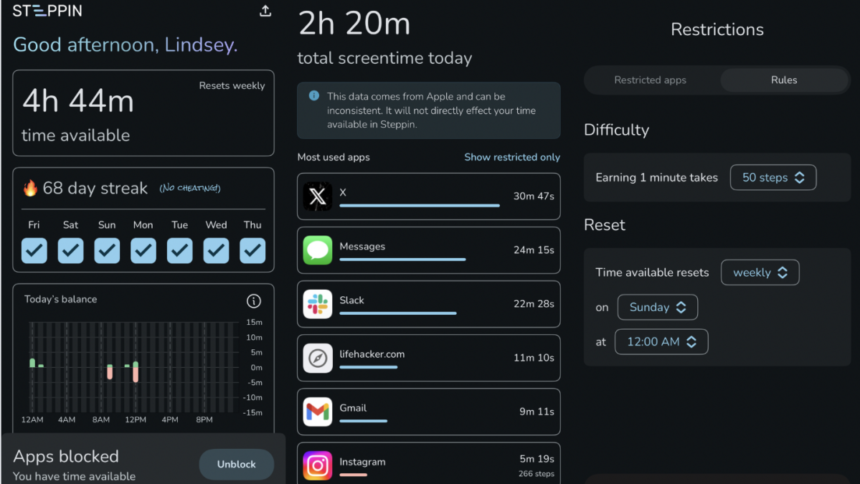Transforming My Digital Habits with the Steppin App
A couple of months back, the Steppin App caught my attention. This innovative tool limits access to your most distracting applications, compelling you to earn minutes in exchange for your real-life steps. Just within the first three days, I was enjoying the app enough to write a review. Fast forward to 68 days later, my appreciation for it has deepened. While it is currently only accessible on iOS with an Android version awaiting launch, my navigation and integration with daily life have become smoother.
Reduced Social Media Engagement
The app syncs with Apple Health to track the steps recorded by your phone or fitness tracker, converting them into minutes redeemable on your favorite apps. When you add an app to the blocklist, opening that app prompts you to access Steppin instead. You can choose between spending one to thirty minutes unlocking the app or simply giving up on it. My settings allow me to unlock one minute for every 50 steps taken.
Initially, I placed two applications—Instagram and a game named Project Makeover—on my blocklist, and my engagement with them has significantly decreased. This is beneficial; I can’t remember the last time I watched a trivial Reel. However, this shift has slightly affected my social interactions. Instagram serves as a platform where connections announce significant life events, so I’ve missed a few milestone presentations from acquaintances who aren’t my closest friends. Consequently, I feel impolite for not “liking” or congratulating them in direct messages when I’m eventually made aware of their news days later. While my mom insists that “social media isn’t real life,” that viewpoint seems less applicable these days. The trade-off is curious, though, as I recognize the absence of mindless scrolling has cost me some real-life interactions.
That said, the time gained is invaluable, and I’m thankful for it. Weekly checks on my screen time reveal a steady decline. This week, my daily average is down by 18% from last week, “pickups”—the instances of unlocking my phone—are down by 14%, and average notifications have decreased by 8%. Although Poshmark’s notifications, which exceeded 6,000, skew the statistic a bit since I get alerts for every share, like, or sale, I’ve adjusted those notifications to quietly appear without lighting up my lock screen.
The dopamine hits from scrolling through short videos and bite-sized opinions have less allure now. The absence has worked like a detox, affecting my cravings for the sensational content that used to entice me. That said, I have found myself drawn into other apps I didn’t previously visit much—essentially, my former Instagram time simply redirected elsewhere. For a period, I caught myself spending excessive time on X but promptly added it to my Steppin blocklist.
The Appeal of Streaks
Motivation often stems from arbitrary personal incentives. My Peloton workout streak urges me to exercise daily. My self-care streak on Finch encourages logging daily achievements. Even my Poshmark listing streak and my purchase streak on the Dunkin’ Donuts app grant real-world advantages like discounted shipping and complimentary coffee. Thus, it’s no shock that the Streak feature on Steppin has effectively kept me engaged.
To maintain the streak, one must not remove any apps from the blocklist or bypass the app to access blocked applications. I take pride in having maintained my streak for 68 days, and adding new apps to the blocklist does not reset this progress, nor does adjusting the steps required for unlocking one minute.
Consistent Steps Despite Changes
My usage of distracting apps has certainly plunged, and I’m already noticing the benefits. However, Steppin aims to motivate increased activity, theoretically providing a dual advantage. Before downloading, I was already fairly active, so I haven’t observed a notable rise in my daily step average. I teach up to four spin classes a week while engaging in cardio workouts on my Peloton—these actions burn calories but do not contribute to step counts. Daily, I walk just as much as before, whether heading to the post office, Dunkin’, or the gym.
Interestingly, I find myself voluntarily walking further distances than I used to. Occasionally, instead of taking my Poshmark deliveries to a nearby post office, I walk to one about ten blocks away. I also get off the bus early to stroll a bit, likely encouraged by the warmer weather. I recognize that my motivation stems from wanting to earn minutes for Instagram, yet I seldom use those minutes. Each Sunday at midnight, my accumulated minutes reset, typically amounting to five to six hours of unused time. It becomes frustrating to wake each Sunday with no chance to even scroll through Instagram while I prepare my morning coffee and brush my teeth. I resort to pacing in circles in my living room, generating steps; however, compromising that time would risk my streak, which I am unwilling to do.
Currently, my Apple Health data indicates my average steps remain consistent compared to last year. Still, I view it as an achievement that I’m consciously opting for additional walking opportunities. This week alone, I opted for a golfing trip for leisure, chose to walk around a shopping center instead of ordering online for summer clothes, and even engaged in guided walking workouts via Peloton, diverting from my usual bike cardio. These behaviors undoubtedly stem from Steppin, steering me towards healthier daily choices.
In previous discussions with the app’s creator, Paul English, he shared aspirations to incorporate elements beyond steps into the rewards system, possibly including reading time on devices like Kindles. This would be a welcomed feature. It would be great if my workouts recorded by Apple Health—like cycling or strength training—could translate into Steppin time, although at this moment, the appeal of social media has diminished significantly for me.












